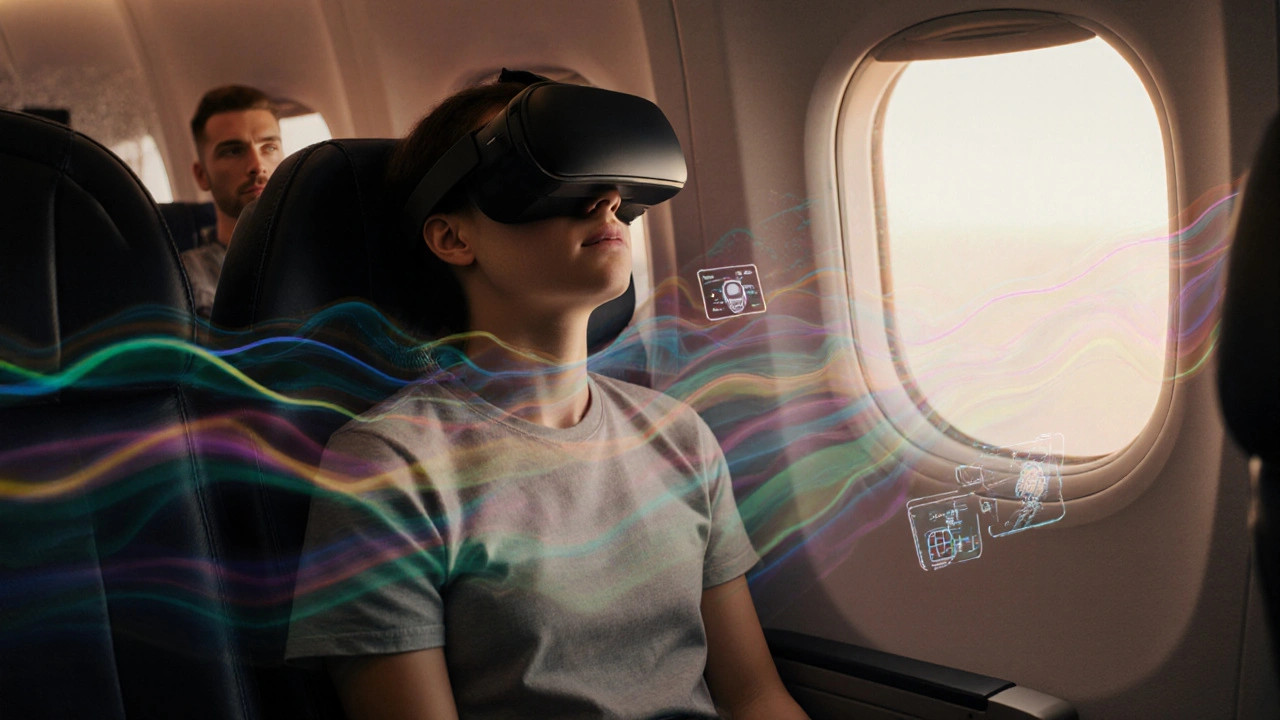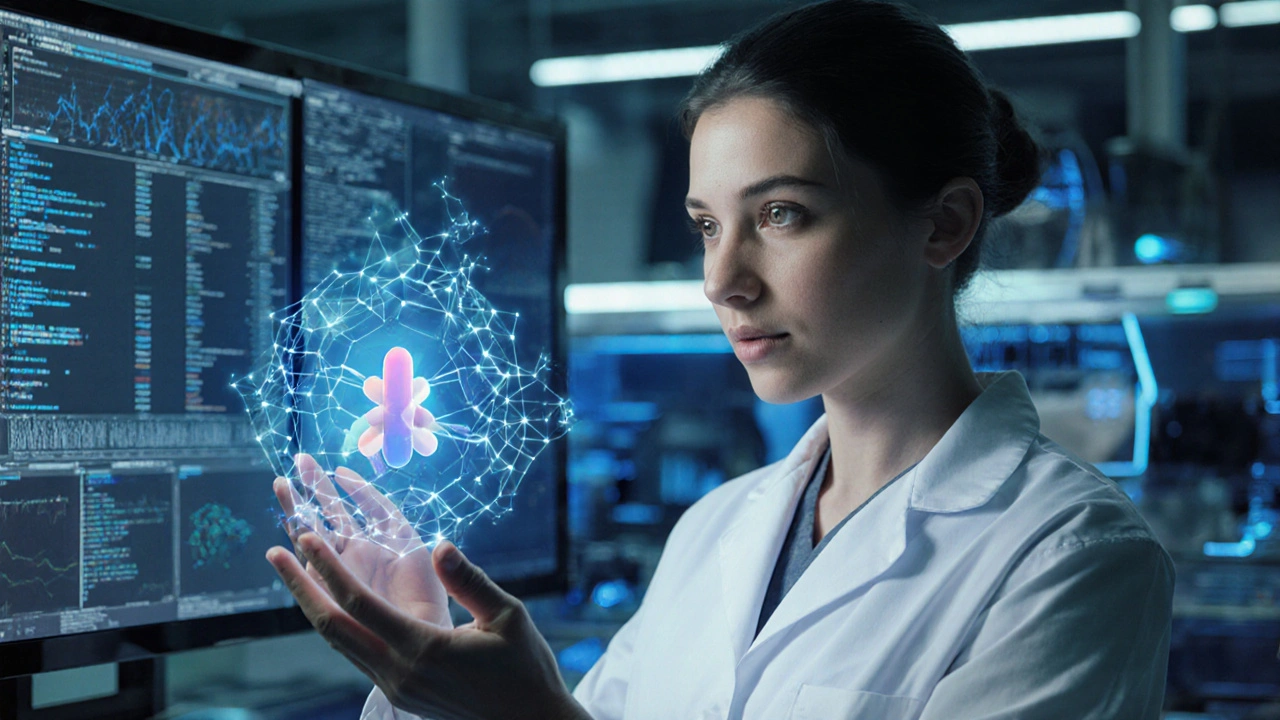Key Takeaways
- New drug formulations and drug‑delivery systems are cutting onset time for nausea relief.
- Wearable neurostimulation devices target the vestibular nerve with minimal side effects.
- Virtual‑reality based desensitization programs are showing real‑world effectiveness for travelers and gamers.
- AI‑driven discovery pipelines are fast‑tracking novel anti‑motion‑sickness compounds.
- Combining traditional meds with modern therapies offers the most reliable symptom control.
When you feel that queasy twist in the stomach on a boat or in a car, you’re experiencing Motion sickness is a disorder of the vestibular system that triggers nausea, dizziness, and cold sweats during motion. For decades, treatment meant popping an antihistamine or sticking a scopolamine patch behind the ear. Today, a wave of tech‑driven and biologically precise solutions is reshaping how we fight that uncomfortable spin. This guide walks you through the science, the newest options, and practical steps to keep your head steady the next time you set sail.
How Motion Sickness Happens
The core player is the vestibular system, a network of fluid‑filled canals in the inner ear that monitors balance and motion. When the brain receives mismatched signals-say, the eyes see a stationary screen while the inner ear senses motion-it triggers a defensive response: nausea, vomiting, and dizziness. This sensory conflict theory explains why you feel sick on a smooth‑ride simulator or while reading in a moving vehicle.
Genetics, age, and prior exposure also affect susceptibility. Younger passengers, especially children, tend to have a more reactive vestibular system, while some adults develop tolerance after repeated exposure. Understanding the underlying pathways helps us design targeted interventions.
Traditional Pharmacological Options
For most people, the first line of defense remains medication. Here’s a quick snapshot of the classics:
| Treatment | Mechanism | Onset | Typical Side Effects | Best For |
|---|---|---|---|---|
| Antihistamine (e.g., dimenhydrinate) | Blocks H1 receptors in the vestibular nuclei | 30‑60min | Drowsiness, dry mouth | Short trips, occasional use |
| Scopolamine patch | Anticholinergic; reduces vestibular input | 1‑2h (patch applied 4h before travel) | Blurred vision, dry eyes | Long journeys, sea travel |
| Ginger capsules | Natural anti‑emetic compounds (gingerols) | 15‑30min | Rare, mild heartburn | Pregnant travelers, mild cases |
| Neurostimulation wristband | Electrical micro‑pulses to vestibular nerve | Immediate | Skin irritation (rare) | Tech‑savvy users, frequent flyers |
| VR desensitization program | Gradual exposure to motion cues in a controlled environment | Weeks of training | Transient discomfort | Gamers, pilots, chronic sufferers |
While effective, these options have trade‑offs. Antihistamines can make you sleepy on a day you need to stay alert. Scopolamine patches require careful timing and can cause vision issues. The goal of new advances is to keep relief fast while cutting down those drawbacks.
Emerging Pharmacological Innovations
Pharma companies are now engineering molecules that act directly on the brain’s nausea centers without the sedative baggage. Two notable developments:
- NK1 receptor antagonists (e.g., tradipitant) block substance‑P signaling, which is a key driver of vomiting reflexes. Early trials show a 45% reduction in nausea scores compared to placebo, with minimal drowsiness.
- Ondansetron nasal spray delivers a rapid anti‑emetic dose directly to the bloodstream, cutting onset time to under five minutes. This formulation is especially useful for motion‑induced nausea during short, intense rides.
Both agents are in PhaseIII trials slated for FDA review in 2026, promising a prescription‑only option that rivals over‑the‑counter pills but with a cleaner side‑effect profile.
Wearable Neurostimulation Devices
Imagine a lightweight band that sends gentle electrical pulses to the vestibular nerve, calming the “conflict” signal before it reaches the brain. That’s the premise behind the newest generation of vestibular neurostimulation wearables, which blend bio‑feedback sensors with targeted micro‑current therapy. A 2024 pilot study of 120 frequent travelers reported a 60% drop in self‑rated dizziness after a single 15‑minute session before boarding.
Key advantages:
- Non‑pharmacologic-no drug interactions.
- Immediate effect, adjustable intensity.
- Reusable and eco‑friendly.
The downside is cost; devices run between $250‑$350, though insurance plans are beginning to recognize them as “medical devices” for chronic vestibular disorders.

Virtual‑Reality and Augmented‑Reality Desensitization
VR isn’t just for gaming; it’s a therapeutic platform. Researchers at the University of Colorado built a 12‑week program where participants wear a headset that simulates progressive motion scenarios-from gentle rocking to turbulent sea states. The brain learns to reconcile visual and vestibular cues, reducing real‑world motion sickness by up to 70%.
AR adds a twist by overlaying stabilizing visual anchors on the real environment-think a digital horizon line that stays level no matter how the car moves. Early commercial products target cruise‑line passengers and airline crew, offering a quick “pre‑flight” session that can be done in airport lounges.
These tools work best when paired with traditional meds for breakthrough episodes, creating a layered defense strategy.
AI‑Driven Drug Discovery and Personalized Treatment
Big data meets inner‑ear biology. Companies like DeepMedi use AI algorithms to scan millions of molecular structures for vestibular‑targeting properties. In 2025, their platform identified a novel peptide that binds to the calcium‑sensing receptor in the vestibular hair cells, modulating signal strength without sedation.
What makes this exciting is personalization. Genetic testing can reveal variations in the CYP2D6 enzyme, which affects how quickly antihistamines are broken down. Armed with that info, doctors can prescribe the exact dosage or choose a non‑metabolized peptide therapy, dramatically improving outcomes.
Practical Checklist for Anyone Facing Motion Sickness
- Consult a healthcare professional if you experience severe or persistent symptoms.
- Start with non‑pharmacologic steps: hydrate, focus on a stable horizon, and avoid heavy meals before travel.
- Choose a medication based on trip length: antihistamines for short rides, scopolamine patch for long cruises.
- Consider trying ginger or a low‑dose OTC supplement at least 30 minutes before boarding.
- If you travel frequently, evaluate a vestibular neurostimulation wearable-check insurance coverage.
- For chronic sufferers, enroll in a VR desensitization program or seek vestibular rehabilitation therapy.
- Stay informed about upcoming FDA approvals for NK‑1 antagonists and nasal ondansetron-these may become prescription options in 2026.
By mixing immediate relief methods with long‑term conditioning, you can drastically cut down the dreaded nausea spikes.
Future Outlook
The next decade will likely see a convergence of three trends:
- Precision pharmacology: AI‑chosen molecules tailored to a patient’s genetic makeup.
- Integrated wearables: Devices that monitor motion, heart rate, and skin conductance, then auto‑trigger neurostimulation or a mild drug dispenser.
- Digital therapeutics: Subscription‑based VR/AR platforms that adapt scenarios in real time, becoming a standard part of travel itineraries.
For now, the real win is that you have more tools than ever to keep your stomach settled and your journey enjoyable.
Frequently Asked Questions
What is the fastest‑acting medication for motion sickness?
Ondansetron nasal spray can start relieving nausea within five minutes, making it the quickest non‑invasive option currently in clinical trials.
Are vestibular neurostimulation wearables safe for children?
Most manufacturers set a lower intensity limit for users under 12. Pediatric trials are ongoing, but early data suggest they are safe when used under medical supervision.
Can I combine ginger with prescription medication?
Ginger has a mild anti‑emetic effect and typically does not interact with antihistamines or scopolamine. However, always check with your doctor before mixing supplements with prescription drugs.
How does VR desensitization differ from regular motion exposure?
VR allows controlled, incremental exposure to motion cues without the physical motion that triggers severe symptoms, enabling the brain to adapt safely.
Will insurance cover new motion‑sickness treatments?
Coverage varies. Some plans already reimburse vestibular rehabilitation and neurostimulation devices. As FDA approvals expand, insurers are expected to update their policies.



Rex Peterson
Considering the intricate interplay between the vestibular apparatus and cortical nausea centers, the emergence of targeted NK‑1 antagonists represents a noteworthy paradigm shift. By modulating substance‑P signaling without invoking significant anticholinergic activity, these agents promise efficacy with a reduced sedative footprint. Moreover, the pharmacokinetic profile outlined in recent Phase III data suggests a rapid onset compatible with acute travel scenarios. It is also philosophically intriguing that we are moving from symptom‑masking toward addressing the underlying neurochemical cascade. Such a trajectory aligns with a broader epistemic movement in medicine, where precision supersedes blanket inhibition.